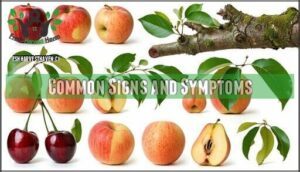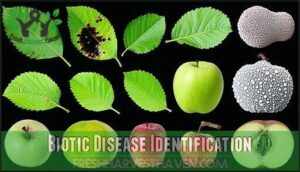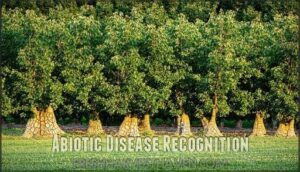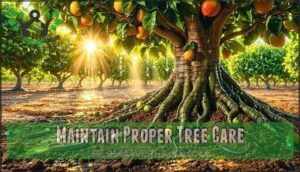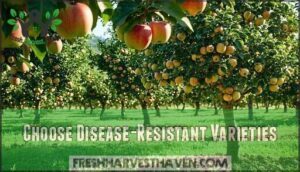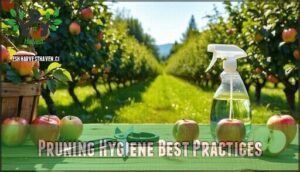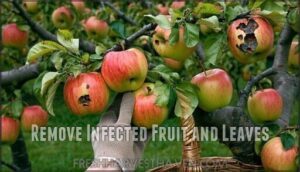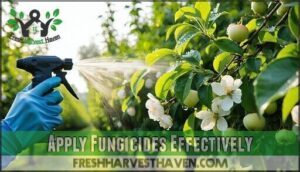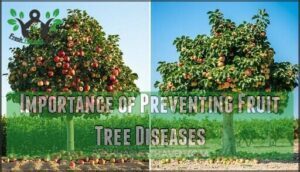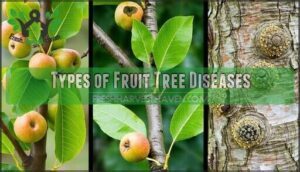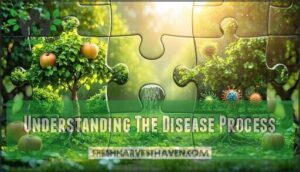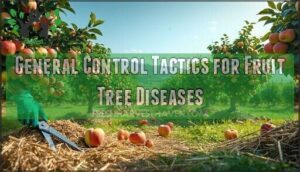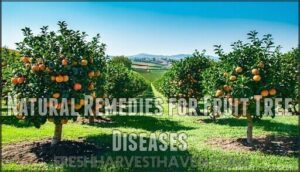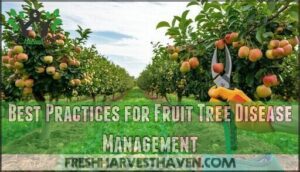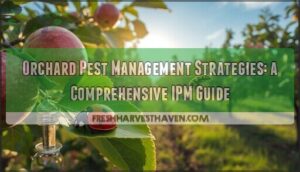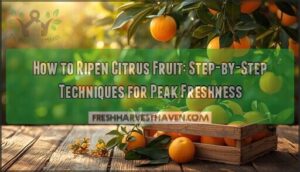This site is supported by our readers. We may earn a commission, at no cost to you, if you purchase through links.
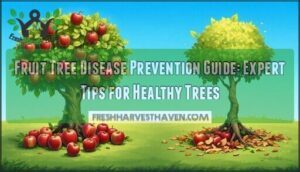
Regular monitoring combined with smart cultural practices—removing fallen debris, promoting good air circulation, and avoiding overhead watering—forms the backbone of successful prevention strategies that keep your orchard thriving year after year.
Table Of Contents
- Key Takeaways
- Common Fruit Tree Diseases
- Identifying Fruit Tree Diseases
- Prevention Methods for Fruit Tree Diseases
- Importance of Preventing Fruit Tree Diseases
- Types of Fruit Tree Diseases
- Understanding The Disease Process
- General Control Tactics for Fruit Tree Diseases
- Natural Remedies for Fruit Tree Diseases
- Best Practices for Fruit Tree Disease Management
- Frequently Asked Questions (FAQs)
- How do you prevent fruit tree diseases?
- What causes disease in fruit trees?
- How do I know if my fruit tree is diseased?
- Can a fruit tree get bacterial canker?
- Can volunteers pick fruit if a tree has a disease or pest?
- Does WSU have a quarantine policy for tree fruit?
- What can you do to prevent fruit tree diseases?
- What should you do when you notice a problem with your fruit tree?
- What should you do with affected parts of a diseased tree?
- Is it safe to eat fruits from fruit trees?
- Conclusion
Key Takeaways
- Choose disease-resistant varieties and proper rootstocks as your foundation—they’re your best defense against local pathogens like fire blight and apple scab, naturally fighting off infections without requiring chemical treatments.
- Maintain excellent pruning hygiene by sterilizing tools between cuts with 70% alcohol, removing infected branches during dormant seasons, and improving air circulation to reduce humidity that fungi love.
- Practice consistent orchard sanitation by immediately removing fallen leaves, infected fruit, and diseased debris—this breaks disease cycles and can reduce your disease problems by up to 70%.
- Apply preventive treatments like copper fungicides during dormant seasons and monitor your trees weekly during the growing season, catching problems early before they spread throughout your orchard.
Common Fruit Tree Diseases
Fruit trees face several common diseases that can devastate your harvest if left unchecked.
Recognizing these threats early gives you the best chance to protect your trees and maintain healthy, productive orchards.
Black Rot Symptoms and Signs
Black Rot transforms your fruit trees into a battleground of distinctive symptoms you can’t miss. Those telltale "frogeye" spots on leaves—purple-edged circles expanding to brown centers—signal trouble ahead. Within weeks of infection, 95-100% of affected leaves develop these characteristic Leaf Frogeye patterns with multiple black dots visible under close inspection.
Your fruit suffers next. Single Fruit Lesions appear at the calyx end, creating firm, leathery decay with alternating black and brown concentric rings. Meanwhile, Limb Cankers form sunken, reddish-brown areas that expand 10-22 centimeters annually, exposing rough bark as margins loosen and scale away. This disease is caused by the fungus Botryosphaeria obtuse.
Watch for these critical Disease Symptoms:
- Purple leaf spots expanding into distinctive frogeye patterns within two weeks
- Sunken branch cankers with raised, lobed margins and black pycnidia structures
- Firm fruit rot displaying concentric rings and peculiar fruity odor in 75% of cases
Apple Scab Causes and Effects
Apple trees face a persistent enemy in apple scab, a fungal disease caused by Venturia inaequalis. This scab pathogen overwinters in fallen leaves, releasing spores during wet spring weather between 6°C and 24°C. You’ll spot olive-green lesions on leaves that darken over time, while fruit blemishes develop into corky, brown patches that crack and distort your apples. To combat this issue, consider utilizing resistant apple cultivars in your orchard.
| Disease Stage | Symptoms | Economic Impact |
|---|---|---|
| Early infection | Olive-green leaf spots | Reduced photosynthesis |
| Fruit development | Corky brown patches | Unmarketable fruit |
| Severe cases | Leaf defoliation | 20-70% yield reduction |
Wind and rain carry these spores everywhere, so you really need to stay on top of control measures.
Skip proper prevention and you could lose a huge chunk of your harvest—sometimes most of it.
Getting your timing right with fungicide applications makes all the difference between a good year and a disaster.
Black Knot Identification and Treatment
If you’ve ever seen what looks like black rope twisted around your tree branches, you’re looking at one of the most destructive fungal diseases in stone fruit orchards. Black knot identification starts with recognizing those hard, coal-black galls that strangle cherry and plum trees.
Effective pruning techniques require cutting infected branches 6-8 inches below visible knots during dormancy, while sterilizing tools between cuts prevents disease spread.
- Warty growths that start as small brown swellings before hardening into twisted black masses
- Branch strangulation where the fungus wraps around limbs like a rough, dark tourniquet
- Tool sterilization between each cut using bleach solution to stop spore transmission
Fungicide options include preventative copper sprays during bud break, though tree recovery depends on early detection and aggressive pruning for long-term fruit tree disease prevention success.
Cherry and Plum Leaf Spot Prevention
Picture tiny purple spots slowly conquering your cherry tree’s leaves like paint splatters on a green canvas—that’s cherry and plum leaf spot making its grand entrance into your orchard. This fungal disease spreads through moisture, causing defoliation that weakens trees and reduces fruit quality.
Your disease prevention strategies should focus on these key areas:
- Orchard sanitation through fall leaf removal eliminates overwintering spores
- Pruning methods that improve air circulation reduce humidity around foliage
- Variety resistance selection offers natural protection against infection
- Fungicide timing during early spring provides essential preventive coverage
Smart fungicide application combined with proper cultural practices keeps your trees healthy.
Peach Scab and Leaf Curl Management
When peach trees start looking like they’ve been through a boxing match, with curled, reddish leaves and scabby fruit, you’re dealing with two of the most stubborn fungal foes in the orchard. Peach leaf curl strikes early, causing those telltale twisted leaves, while peach scab creates unsightly spots on fruit.
The scab life cycle thrives in wet spring weather, so timing your fungicide application before bud break is essential. Resistant cultivars like ‘Indian Free’ offer a natural defense, and proper pruning techniques improve air circulation to prevent these fungal diseases.
Identifying Fruit Tree Diseases
Catching fruit tree diseases early is like spotting trouble before it spreads through your entire orchard.
You’ll need to know what to look for, from obvious symptoms like spotted leaves to subtle signs that something’s not quite right with your trees.
Common Signs and Symptoms
Think of your fruit trees as constantly sending you messages about their health—the trick is learning to read the signals before it’s too late. Leaf spot patterns appear as circular dark patches or yellowing areas that spread across foliage. Fruit discoloration shows up as sunken, brown lesions or unusual color changes on your harvest. Bark abnormalities include cracks, cankers, or strange growths on trunks and branches. Watch for growth deformities like stunted leaves, twisted branches, or unusual wilting during normal weather.
Catch these warning signs early and you can stop most diseases in their tracks—way easier than trying to save a tree that’s already struggling.
Biotic Disease Identification
Most fruit growers face biotic diseases caused by living organisms—bacteria, fungi, and viruses that attack your trees. Visual symptom evaluation remains your starting point, but lab analysis often takes three weeks for definitive results. Rapid field tests now identify major pathogens in thirty minutes, while molecular diagnostics detect minute pathogen DNA within hours.
Mixed infections complicate diagnosis since forty percent of symptomatic samples reveal multiple pathogens. Genetic variability in viral populations means conventional tests sometimes miss infections.
- Bacterial fruit tree diseases like fire blight cause sudden wilting and blackened shoots
- Fungal fruit tree diseases create spots, cankers, and powdery growths on leaves and fruit
- Viral diseases produce mottled leaves, stunted growth, and reduced fruit quality over time
- Disease symptoms often overlap between pathogen types, requiring laboratory confirmation for accuracy
Abiotic Disease Recognition
Diagnosing abiotic disorders in orchards can be tough since they often look just like infectious diseases. But these non-living stressors create damage patterns that are actually quite different from what pathogens cause.
The biggest giveaway is how uniform the symptoms are—abiotic stress hits entire sections or blocks all at once, not the spotty spread you see with diseases. And when you examine the affected tissue, you won’t find any fungi, bacteria, or other pathogens.
Watch for these telltale signs:
- Leaf edges burning and yellowing between veins (usually from nutrient problems or too much salt)
- Fruit dropping uniformly with stunted growth—drought can reduce fruit size by 36-49%
- Sunscald creating white, cracked patches on exposed bark
- Whole rows wilting from compacted soil or chemical damage
When you measure chlorophyll levels or notice delayed ripening, these numbers back up what you’re seeing. Getting this diagnosis right is key to preventing future problems and keeping your trees healthy.
Environmental Stress Factors
Your trees face an invisible battle every day—environmental stress that weakens their natural defenses and rolls out the red carpet for disease. Weather extremes, poor soil conditions, and water stress create perfect storm conditions for pathogens.
| Stress Factor | Impact on Tree Health | Disease Risk |
|---|---|---|
| Temperature fluctuations | Weakened disease resistance | High pathogen activity |
| Poor air circulation | Increased humidity levels | Fungal disease development |
| Nutrient deficiencies | Compromised immune system | Bacterial infections |
| Compacted soil | Root stress, poor drainage | Root rot diseases |
| Air quality issues | Reduced photosynthesis | Overall tree decline |
Monitor your soil health and maintain proper orchard sanitation to strengthen your trees’ natural defenses.
Prevention Methods for Fruit Tree Diseases
Prevention beats cure for fruit tree diseases, and the right strategies can save you time, money, and heartache down the road.
Five key strategies can protect your trees from the diseases that kill orchards.
Maintain Proper Tree Care
Just like a plant’s immune system, healthy trees naturally resist disease better than stressed ones. Start with soil health—test annually and keep pH between 6.0-7.0 for optimal nutrient uptake. Water deeply once a week instead of daily sprinkles that create the humid conditions fungi thrive in.
Balanced fertilization based on soil tests keeps trees well-nourished, while a good layer of mulch retains moisture and regulates root temperature. Most fruit trees need at least six hours of direct sunlight daily.
Key practices for strong, disease-resistant trees:
- Regular pruning to remove dead wood and boost airflow
- Proper spacing between trees for good air circulation
- Deep, consistent watering schedules
- Annual soil amendments based on test results
- Seasonal cleanup of fallen fruit and debris
When you nail these basics, diseases have a much harder time taking hold.
Choose Disease-Resistant Varieties
Picking the right variety is like choosing a superhero with the perfect powers for your specific villains. Look for disease-resistant varieties bred for your regional adaptations—they’re your best defense against local pathogens.
Modern rootstock resistance and genetic diversity mean you’re getting trees that can handle bacterial canker, fire blight, or whatever your area throws at them. Smart varietal selection beats spraying any day.
Pruning Hygiene Best Practices
Think of your pruning tools as surgical instruments—one dirty blade can spread disease through your entire orchard faster than gossip at a farmer’s market. Tool Sterilization between cuts using 70% alcohol or 10% bleach solution transforms your shears from disease carriers into healing instruments. Pruning Timing during dormant seasons reduces pathogen activity, while Proper Cuts at 45-degree angles promote faster healing and prevent water damage.
Essential Orchard Sanitation practices for improved Tree Health:
- Sterilize tools after every diseased branch to stop cross-contamination
- Remove debris immediately—diseased wood becomes a breeding ground for future infections
- Seal large wounds over 2 inches with pruning paint to block pathogen entry
Smart pruning opens up your canopy, letting air flow freely and keeping moisture levels down where pathogens can’t thrive.
Sealing cuts properly and cleaning up fallen debris gives you a complete shield against diseases spreading through your orchard.
Remove Infected Fruit and Leaves
When disease strikes your fruit trees, infected debris becomes a breeding ground that can turn a small problem into an orchard-wide disaster. That’s why sanitation importance can’t be overstated—removing infected fruit and leaves stops disease spread before it spirals out of control.
Act fast when you spot symptoms. Collect fallen debris immediately, especially after storms when pathogens thrive in wet conditions. Your disposal methods matter enormously: bag infected materials for municipal waste, never your compost pile. Composting risks are real because home systems rarely reach temperatures needed to kill pathogens.
This cultural practice forms the backbone of effective disease management. Regular cleanup breaks infection cycles, dramatically reducing disease pressure. It’s one of your most powerful preventive measures—simple orchard sanitation that delivers lasting results through consistent disease control tactics.
Apply Fungicides Effectively
Fungicides aren’t magic bullets—they’re precision tools that demand respect, timing, and technique to shield your fruit trees from fungal devastation. Success starts with fungicide timing—begin applications before bud break in early spring, then maintain regular coverage every 7-14 days during critical infection periods.
Copper fungicides work exceptionally well for bacterial canker and peach leaf curl, while organic fungicides offer gentler environmental impact without sacrificing protection.
Here’s your strategic approach:
- Master coverage techniques by spraying all leaf surfaces, including undersides where spores lurk
- Perfect product selection based on target diseases and weather conditions
- Practice resistance management by rotating fungicide classes throughout the season
- Time chemical protection around weather patterns—never spray before rain
Remember, fungicide application isn’t about drowning your trees in chemicals. It’s about strategic protection that keeps diseases at bay while preserving beneficial insects and soil health.
Importance of Preventing Fruit Tree Diseases
Preventing fruit tree diseases isn’t just about keeping your trees looking good—it’s about protecting your investment and guaranteeing a reliable harvest for years to come.
When you take steps to prevent disease, you’re safeguarding your tree’s ability to produce quality fruit while avoiding costly treatments and potential tree loss down the road.
Economic Benefits of Disease Prevention
Smart orchard management delivers real returns when you prioritize disease prevention. Research shows that preventing problems before they start can increase yields by up to 30% compared to orchards that just react to issues as they come up. The profitability gains are substantial—every dollar you put into prevention brings back $150, and Pennsylvania growers are saving $37.50 per acre each year through smart management practices.
This proactive approach does more than protect your bottom line. It helps preserve nearly 8,000 full-time jobs across the agricultural supply chain. Consumers benefit too, with more stable pricing and reliable fruit supplies year after year.
When you invest in tree health through integrated pest management and preventive care, you’re essentially shifting your whole operation. Instead of constantly fighting expensive crises, you build a sustainable system that generates steady income for decades.
Environmental Impact of Disease Prevention
Smart orchards become environmental heroes when you prevent diseases naturally. IPM benefits include 30-50% fewer pesticide applications, dramatically reducing pesticide runoff and soil contamination. Regenerative practices boost soil organic matter by 18% while protecting beneficial insects from chemical harm.
- Organic solutions eliminate harmful residues that persist 100 days post-application
- Cultural practices like grassed inter-rows prevent waterway pollution during rainfall
- Integrated pest management aids biodiversity and pollinator populations
- Sustainable fruit production reduces greenhouse gas emissions through lower input reliance
Food Safety and Security
Your family’s health depends on the fruit that comes from your trees. Prevention is your first line of defense against contaminated harvests. When you keep diseases in check, you’re protecting consumer confidence and making sure your fruit meets safety standards before it hits store shelves. Control diseases early, and you’re also safeguarding the local sourcing opportunities and global trade relationships that rely on quality produce.
Solid tree health management delivers real food safety benefits:
- Preventive measures wipe out harmful pathogens before fruit even starts developing
- Disease control tactics naturally cut down on chemical residue worries
- Sustainable fruit production keeps nutritional value steady year after year
- Supply chain integrity keeps food accessible in your community
- Early intervention stops contaminated fruit from ever making it to distribution
The prevention work you do today shapes food security for your neighbors, your region, and beyond.
Long-Term Tree Health
A healthy fruit tree today becomes a family legacy that feeds generations tomorrow. Smart varietal selection sets the foundation—choosing varieties with natural pest resistance and climate resilience means fewer headaches down the road. Proper soil health and root development create strong trees that weather storms, droughts, and disease pressure. Your integrated pest management approach, combined with consistent orchard sanitation, protects this investment for decades.
- Disease-resistant rootstocks can produce fruit for 50+ years with minimal intervention
- Healthy soil microbiomes naturally suppress pathogens while boosting tree immunity
- Preventive tree health management costs pennies compared to replacing mature orchards
Types of Fruit Tree Diseases
Fruit trees face three main types of diseases that can wreck your harvest and weaken your trees.
Understanding bacterial, fungal, and viral diseases helps you spot trouble early and take the right action to protect your orchard.
Bacterial Diseases and Their Effects
Four major bacterial diseases devastate fruit trees annually. Fire blight creates blackened, burned-looking shoots during bloom, causing over $100 million in U.S. losses yearly. Bacterial canker forms sunken bark lesions leading to branch dieback. Crown gall produces tumor-like growths that can reach 99% infection rates in waterlogged soils. Bacterial leaf spot creates dark holes in foliage, making up to 50% of fruit unmarketable in severe cases.
Disease spread accelerates through contaminated tools, rain splash, and insects, with bacterial resistance complicating control advances in modern orchards.
Fungal Diseases and Their Symptoms
Fungal infections in fruit trees don’t need wounds like bacterial diseases do—they spread through airborne spores that settle on perfectly healthy tissue. Getting ahead of these persistent diseases means learning to spot the early warning signs and acting fast.
Apple scab shows up as olive-green blotches on leaves and creates those telltale corky patches on your fruit. Black rot is easier to catch—look for purple spots with tiny black dots in the center. Powdery mildew lives up to its name, coating leaves and shoots with what looks like white dust.
Humid weather is when things get tricky. That’s prime time for spores to multiply and spread throughout your orchard, turning a small problem into a major headache.
Viral Diseases and Their Transmission
Think of viral diseases as the master infiltrators of the fruit tree world—once they slip past your defenses, there’s no going back. These plant diseases spread through multiple pathways, making virus identification essential for your orchard’s survival.
Viral vectors transmit pathogens through:
- Insect vectors like aphids carrying viruses between trees
- Graft transmission from infected rootstock during the disease process
- Seedborne viruses passing infections to new generations
- Contaminated tools spreading viral infections during pruning
Resistance breeding offers your best protection against these relentless invaders.
Understanding The Disease Process
To prevent diseases effectively, you need to understand how they actually develop in your fruit trees. Think of disease as a puzzle with three essential pieces: a susceptible host (your tree), a pathogen (the disease-causing organism), and the right environmental conditions that bring them together.
The Disease Triangle Explained
Behind every fruit tree disease lies a fundamental framework called the disease triangle. This concept shows how three critical elements must align for plant diseases to take hold: Host Susceptibility, Pathogen Dynamics, and Environmental Factors.
When your tree can’t resist specific plant pathogens, aggressive disease-causing organisms are present, and conditions favor infection, the disease process begins. Triangle Disruption becomes your strongest defense strategy. Remove any single element—strengthen tree resistance, reduce pathogen presence, or modify environmental conditions—and you’ll prevent disease development.
Scientists are now looking at how the microbiome fits into this picture, turning the simple triangle into something more nuanced that gives us better ways to spot problems before they start.
Pathogen and Host Interaction
Every time a pathogen meets your fruit tree, it’s like watching a microscopic chess match where both players are fighting for survival. Your tree deploys Host Defense Mechanisms—think of them as cellular bodyguards that recognize invaders and mount a Plant Immune Response. Meanwhile, plant pathogens counter with their own Pathogen Virulence Factors, biological weapons designed to break down your tree’s defenses.
This ongoing battle reflects millions of years of Co-evolution Dynamics between fungi, bacteria, and their plant hosts. Some trees carry Disease Resistance Genes that act like upgraded security systems, while others remain vulnerable targets in the disease triangle.
Understanding this plant pathology helps you make smarter choices:
- Select varieties with proven resistance genes – they’ve already won many battles
- Monitor for early infection signs – catch the chess match before it’s over
- Reinforce your tree’s natural defenses** – healthy trees fight harder and win more often
Environmental Factors in Disease Development
Weather doesn’t just set the mood for your orchard—it literally determines whether diseases thrive or die. Weather Patterns create perfect storms for pathogens when humidity spikes above 85% and temperatures hover between 60-80°F. Poor air circulation traps moisture around leaves, while Soil Conditions like waterlogged roots from Water Stress invite fungal infections.
Climate Change intensifies these risks with unpredictable swings. Your preventive measures should focus on improving soil health through proper drainage and spacing trees for best air flow.
Monitoring and Maintenance Strategies help you track Air Quality and environmental changes before Tree Health suffers.
General Control Tactics for Fruit Tree Diseases
Effective disease management starts with choosing the right foundation and staying vigilant.
You’ll need smart variety selection, regular monitoring, proper sanitation practices, and targeted treatments to keep your trees healthy and productive.
Selection of Varieties and Rootstocks
Choosing the right variety and rootstock is like picking the perfect foundation for your home – get it wrong, and you’ll be fighting problems for years to come. Disease-resistant varieties bred for your local pathogens offer built-in protection against common threats like fire blight and apple scab. Smart rootstock compatibility ensures your tree adjusts to soil conditions while fostering healthy growth habits and excellent fruit quality.
- Disease Resistance: Select varieties proven to resist local diseases, reducing chemical treatments
- Climate Adaptation: Choose trees tested in your growing zone for reliable performance
- Growth Habit: Match tree size to your space and maintenance preferences
- Fruit Quality: Prioritize varieties known for consistent yields and excellent taste
This preventive approach to tree health pays dividends through reduced maintenance and healthier harvests.
Monitoring for Disease Signs
Your trees won’t send you a text when they’re sick, but spotting trouble early can save your entire harvest. Regular tree inspections become your disease management insurance policy—walk through weekly during the growing season, monthly in winter. Look for subtle changes like unusual leaf spots, bark discoloration, or fruit blemishes that signal trouble brewing. The importance of documentation can’t be overstated; keep records with dates and photographic evidence for accurate tracking.
| Disease Signs | Location | Season |
|---|---|---|
| Leaf spots, yellowing | Foliage | Spring-Fall |
| Bark cankers | Trunk, branches | Year-round |
| Fruit rot, blemishes | Developing fruit | Summer |
| Branch dieback | Crown | Winter-Spring |
Early symptom detection through consistent pest monitoring helps you catch Common Fruit Tree Diseases before they spread, making your Monitoring and Maintenance Strategies far more effective.
Cultural Controls and Sanitation Methods
Simple sanitation practices can slash your disease problems by up to 70%, making them your orchard’s most powerful defense system. Think of Orchard Sanitation as your first line of defense—it’s like keeping a tidy house to prevent pests from moving in.
Start with smart Pruning Techniques using disinfected tools between cuts, which dramatically improves air circulation and reduces disease pressure. Remove all fallen leaves, mummified fruit, and infected branches immediately to break disease cycles effectively.
Your Tree Health depends heavily on Soil Health management through organic gardening practices and proper Water Management around tree bases.
Essential Cultural Control Methods:
- Pruning and Air Circulation – Remove diseased branches with sterile tools, thin crowded areas for better airflow
- Orchard Sanitation – Clear fallen debris weekly, destroy infected plant material immediately
- Soil Health Management – Apply organic mulch, improve drainage, practice consistent watering schedules
These practices work together like a well-oiled machine, creating an environment where diseases struggle to establish themselves.
Chemical Protection and Microbicides
When your trees keep getting hit by fungal attacks and bacterial infections, cultural controls alone might not cut it. That’s where chemical treatments come in—they’re your backup when nature throws everything it’s got at your trees.
Timing is everything here. Apply protectant fungicides before any symptoms appear, but if you notice early signs of infection, targeted treatments can still save the day. Choose the right product for the job: copper is effective against bacterial issues, while systemic fungicides tackle fungal problems that have already taken hold.
Chemical Type Target Diseases Best Timing
To prevent pathogens from building resistance, rotate your chemicals annually. Ensure thorough coverage when spraying, and always check the pre-harvest interval if treating fruit trees. Chemicals work best when paired with good cultural practices, providing your trees with robust protection against diseases.
Natural Remedies for Fruit Tree Diseases
When synthetic chemicals aren’t your cup of tea, nature offers plenty of weapons in your disease-fighting arsenal.
You can utilize organic fungicides like neem oil and baking soda sprays, recruit beneficial microorganisms as your tree’s bodyguards, and choose naturally resistant varieties that laugh in the face of common pathogens.
Organic Fungicides and Bactericides
Nature’s pharmacy offers some surprisingly powerful weapons against fruit tree diseases, and many work better than you might expect. Copper fungicides remain the best approach for organic solutions, delivering broad-spectrum protection against bacterial and fungal pathogens while supporting long-term soil health impact. Your homemade solutions can be just as effective – baking soda sprays prevent powdery mildew, while neem oil addresses multiple problems at once.
Nature’s pharmacy packs some surprisingly powerful weapons against fruit tree diseases. Many work better than you’d expect. Copper fungicides still lead the pack for organic solutions – they knock down bacterial and fungal problems while keeping your soil healthy long-term. But don’t overlook homemade remedies that can be just as effective. Baking soda sprays stop powdery mildew in its tracks, and neem oil tackles multiple issues at once.
What actually works for bio-control:
- Copper sulfate reliably crushes bacterial infections
- Baking soda mixtures create conditions fungi hate
- Neem oil treatments give you systemic protection plus pest control
- Compost tea applications flood your trees with beneficial microbes
Your trees get protection without the environmental trade-offs.
Biological Control Agents
Imagine having a team of microscopic bodyguards working 24/7 to shield your fruit trees from disease. That’s exactly what biological control agents deliver through integrated pest management and organic solutions.
- Predatory Insects: Ladybugs and lacewings demolish aphids while beneficial nematodes patrol soil, promoting tree health naturally.
- Beneficial Microbes: These microscopic allies outcompete harmful pathogens, boosting soil health and induced resistance.
- Viral Biocontrol: Specialized biopesticide application targets specific pests without harming your trees.
Cultural Controls and Resistant Varieties
Smart gardeners know that the strongest defense against disease isn’t found in a spray bottle—it’s built right into the tree itself. Disease-resistant varieties form your foundation, naturally fighting off pathogens without chemicals. Proper variety selection matched to your climate creates healthier trees from day one.
Smart pruning methods improve air circulation, reducing moisture that breeds disease. Meanwhile, maintaining soil health through organic solutions and consistent watering practices strengthens your tree’s immune system.
When you combine strategic sunlight needs with regular pruning for better airflow, you’re creating an environment where diseases struggle to take hold—that’s fruit tree disease prevention done right.
Best Practices for Fruit Tree Disease Management
Think of fruit tree disease management as building a fortress around your orchard—you need multiple layers of defense working together.
The key is combining smart prevention tactics, careful monitoring, and strategic partnerships to keep your trees healthy year after year.
Integrated Pest Management (IPM) Strategies
Success with integrated pest management starts with understanding that over 75% of fruit growers have already made IPM adoption their go-to strategy. You’ll build your defense system using three core pillars: cultural practices, biological control agents, and selective chemical applications.
Start by monitoring weekly for pest thresholds, then deploy beneficial insects and mating disruption techniques that can slash pesticide use by 80%. This sustainable pest management approach delivers impressive economic impacts—boosting profit margins by 20% while cutting costs $150 per acre annually.
Sustainable pest management with beneficial insects boosts profit margins by 20% while cutting pesticide use by 80%
The environmental benefits include 70% less contamination and 35% higher biodiversity. Think of IPM as your orchard’s immune system, naturally strengthening defenses while maintaining the delicate balance that keeps your trees healthy and productive year after year.
Record Keeping and Monitoring
Most successful orchard managers can tell you exactly when their last fire blight outbreak started, what treatments they used, and how effective each one proved—because they wrote it all down. Documentation transforms your orchard management from guesswork into precision. Smart record keeping tracks disease patterns, treatment efficacy, and environmental conditions that trigger outbreaks.
Your monitoring system should capture:
- Weekly disease tracking observations for early symptom detection
- Detailed spray schedules with product names and application rates
- Treatment effectiveness ratings and fruit diseases progression notes
- Weather conditions during critical infection periods
- Yield correlation data linking tree health to harvest results
This data analysis becomes your roadmap for integrated pest management decisions. When similar conditions arise, you’ll know exactly which pest control strategies worked best for your specific trees.
That data becomes your crystal ball for pest management. Next time you see those same weather patterns or early symptoms, you’ll already know which treatments actually worked on your trees.
Collaboration With Experts and Neighboring Growers
Building partnerships with neighboring growers isn’t just good neighborliness—it’s your best defense against diseases that don’t respect property lines. Expert knowledge sharing creates powerful community orchard health networks that strengthen everyone’s fruit tree disease prevention efforts.
- Regional disease trends monitoring: Track pest patterns and outbreaks across your area through collaborative IPM strategies
- Shared resource management: Pool equipment costs and preventive measures with neighboring orchards
- Sustainable pest management exchange: Learn proven tree health techniques through community workshops and cooperative programs
Frequently Asked Questions (FAQs)
How do you prevent fruit tree diseases?
Just like how timing matters when harvesting fruit, preventing fruit tree diseases starts with timing too.
You’ll need resistant rootstocks, proper fertilization, strategic pruning, dormant sprays, and orchard sanitation for effective disease-resistant varieties and early detection through careful watering techniques.
What causes disease in fruit trees?
Biotic pathogens attack your fruit trees through three main pathways. Fungal spores spread via wind and water, bacteria enter through wounds, and viral vectors like insects transmit disease between trees.
| Pathogen Type | Common Entry Points |
|---|---|
| Fungi | Wet leaves, poor air circulation, contaminated soil |
| Bacteria | Open wounds, pruning cuts, insect damage |
| Viruses | Insect bites, grafting, contaminated tools |
Environmental stressors weaken your tree’s natural defenses, making fungal infections and bacterial spread more likely when conditions favor disease development.
How do I know if my fruit tree is diseased?
Watch for telltale signs during your Visual Inspection routine: yellowing leaves, unusual spots, stunted growth, or bark discoloration signal Early Symptoms requiring immediate attention and Professional Diagnosis.
Can a fruit tree get bacterial canker?
Bacterial canker strikes like a silent predator, targeting stone fruits and pome trees through wounds and natural openings.
Yes, your fruit tree can absolutely develop bacterial canker, especially during wet, cool conditions when pathogens thrive and spread rapidly between susceptible hosts.
Can volunteers pick fruit if a tree has a disease or pest?
Before allowing volunteers to harvest fruit, assess whether the tree has diseases that could pose fruit safety concerns or disease transmission risks. While bacterial diseases and fungal diseases commonly affect tree health rather than human safety, legal liability aspects and ethical considerations require careful evaluation.
- Evaluate fruit quality for visible signs of disease or pest damage
- Consult local extension services about specific disease transmission risks
- Require volunteers to sign liability waivers before participating
- Implement proper pest control measures before harvest activities
- Monitor weather conditions that could worsen disease development
Does WSU have a quarantine policy for tree fruit?
Like a shield protecting Washington’s orchards, WSU backs quarantine policies requiring all fruit export shipments to be inspected and certified pest-free for specific destination countries.
Federal and state plant quarantine regulations require control of tree fruit diseases for Policy Enforcement protecting fruit movement.
What can you do to prevent fruit tree diseases?
Prevention is your best defense against fruit tree diseases, requiring a strategic approach that combines proper care with smart choices. Here’s what you can do:
- Choose disease-resistant varieties and resistant rootstocks – Start with genetics that naturally fight off common pathogens in your area
- Maintain excellent soil health and air circulation – Well-draining soil and proper spacing between trees create conditions where diseases struggle to take hold
- Practice proper pruning techniques and early detection – Regular pruning removes problem areas while monitoring helps you catch issues before they spread
Apply preventative sprays like dormant oils during the dormant season, and always remove fallen leaves and infected fruit promptly. These simple steps create an environment where your trees thrive and diseases don’t stand a chance.
What should you do when you notice a problem with your fruit tree?
Time is of the essence when disease strikes your fruit tree. Early detection and immediate action prevent small problems from becoming orchard-wide disasters. Identifying fruit tree diseases quickly, then pruning affected areas, removing diseased material, and applying appropriate treatments stops fungal infections and bacterial infections from spreading throughout your tree.
| Action Step | Timeline | Treatment Options |
|---|---|---|
| Initial Assessment | Within 24 hours | Visual inspection, photo documentation, symptom cataloging |
| Immediate Response | Same day | Prune affected branches, remove fallen debris, isolate diseased areas |
| Treatment Application | Within 48 hours | Copper fungicides, organic sprays, targeted bactericides |
| Expert Consultation | Within 3-5 days | Contact extension office, certified arborist, plant pathologist |
| Preventative Measures | Ongoing | Sanitation practices, resistant varieties, monitoring schedule |
Quick response saves your tree’s life and protects neighboring plants from infection spread.
What should you do with affected parts of a diseased tree?
Immediately remove all diseased branches, leaves, and fruit through careful pruning. Burn or bag this infected material—never add it to compost where pathogens survive.
Always sanitize pruning tools between cuts using rubbing alcohol to prevent spreading fungal infections and bacterial infections to healthy tissue.
Is it safe to eat fruits from fruit trees?
When hunger strikes, you can safely harvest fruits from diseased trees if the fruit itself shows no signs of infection.
However, avoid consuming any fruit with visible spots, lesions, or rot to prevent potential health risks.
Conclusion
Protecting your precious fruit trees through proper prevention beats playing catch-up with costly cures. This extensive fruit tree disease prevention guide provides you with proven strategies—from selecting resistant varieties to mastering pruning hygiene and applying targeted treatments.
You’ll save money, protect your harvest, and enjoy healthier trees that produce abundant fruit for years to come.
- https://pmc.ncbi.nlm.nih.gov/articles/PMC11335652/
- https://extension.illinois.edu/news-releases/preventing-fruit-tree-diseases-starts-dormant-season
- https://treefruit.wsu.edu/web-article/disease-management/
- https://rvpadmin.cce.cornell.edu/uploads/doc_299.pdf
- https://www.nationalcleanplantnetwork.org/citrus-threat-of-hlb

